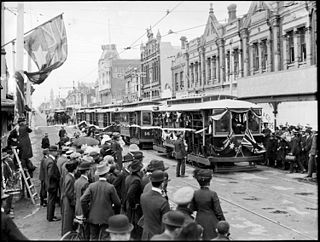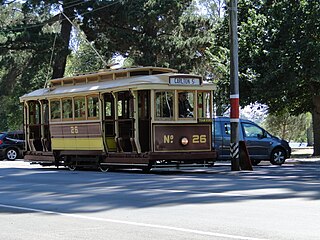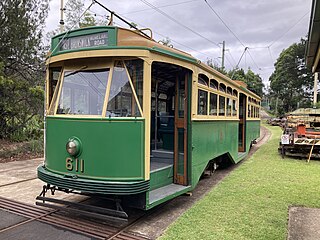Related Research Articles

The Melbourne tramway network is a tramway system serving the city of Melbourne, Victoria, Australia. The tramway network is centred around the Melbourne central business district (CBD) and consists of approximately 1,700 tram stops across 24 routes. It is the largest operational urban tram network in the world and one of the most used, with more than 500 trams and 250 kilometres of double tram track. It served a patronage of 206 million over the year 2017-2018. Trams are the second most utilised form of public transport in Melbourne after the city's metropolitan commuter railway network.

Melbourne tram route 96 is operated by Yarra Trams on the Melbourne tram network from Brunswick East to St Kilda Beach. The 13.9 kilometre route is operated out of Southbank depot with C2, E class, and on occasion A class trams.

Melbourne tram route 75 is operated by Yarra Trams on the Melbourne tram network from Vermont South to Central Pier. The 22.8 kilometre route is operated out of Camberwell depot with A and B class trams. It is the longest route on the network.

A Birney or Birney Safety Car is a type of streetcar that was manufactured in the United States in the 1910s and 1920s. The design was small and light and was intended to be an economical means of providing frequent service at a lower infrastructure and labor cost than conventional streetcars. Production of Birney cars lasted from 1915 until 1930, and more than 6,000 of the original, single-truck version were built. Several different manufacturers built Birney cars. The design was "the first mass-produced standard streetcar " in North America.

Melbourne tram route 78 is operated by Yarra Trams on the Melbourne tram network from North Richmond to Balaclava. The 6.5 kilometre route is operated out of Kew depot with A class trams.

The Melbourne & Metropolitan Tramways Board (MMTB) was a government-owned authority that was responsible for the tram network in Melbourne, Australia between 1919 and 1983, when it was merged into the Metropolitan Transit Authority. It had been formed by the merger of a number of smaller tramway trusts and companies that operated throughout the city.

The W-class trams are a family of electric trams built by the Melbourne & Metropolitan Tramways Board (MMTB) between 1923 and 1956. Over the 33 years of production, 752 vehicles spanning 12 sub-classes were constructed, the majority at the MMTB's Preston Workshops.

The Prahran and Malvern Tramways Trust (PMTT) was a former tram operator in Melbourne, Australia. The trust was formed in 1907, with its first line operating in 1910. Its functions were taken over by the Melbourne & Metropolitan Tramways Board in 1920.
The Hawthorn Tramways Trust was a tram operator in Melbourne, Australia. Its assets and liabilities were transferred to the Melbourne & Metropolitan Tramways Board on 2 February 1920.

The earliest trams in Australia operated in the latter decades of the 19th century, hauled by horses or "steam tram motors". At the turn of the 20th century, propulsion almost universally turned to electrification, although cable trams lingered in Melbourne. In cities and towns that had trams, they were a major part of public transport assets.

The Ballarat Tramway Museum is an operating tramway museum, located in Ballarat, Victoria, Australia. The museum is run by volunteers and has a fleet of trams which operate on part of the original horse tramway around Lake Wendouree and the Botanical Gardens. It has a large research collection, archive of information and more than 3,500 items about the Ballarat tramways. The trams in Ballarat operated on a large network through the city from 1887 until 1971.
The L-class was a class of six trams ordered from James Moore & Sons by the Prahran & Malvern Tramways Trust (PMTT). However, by the time they were delivered in 1921, the PMTT had been taken over by the Melbourne & Metropolitan Tramways Board (MMTB).

The M-class was a class of 17 trams built by Duncan & Fraser, Adelaide for the Hawthorn Tramways Trust (HTT) as numbers 1 to 10, and 33 to 39. All passed to the Melbourne & Metropolitan Tramways Board on 2 February 1920 when it took over the Municipal Tramway Trusts, becoming the M-class and being renumbered 107 to 116, and 183 to 189.
The O-class Melbourne tram were a group of four trams built in 1912 by Duncan & Fraser (Adelaide) for the Prahran & Malvern Tramways Trust (P&MTT) upon the recommendation of W. G. T. Goodman, Chief Engineer and General manager of the Adelaide tramways. They were allocated P&MTT fleet numbers 21 to 24. At the time of their introduction, they were by far the largest street-vehicles in Melbourne, and earned the nicknames Zeppelins and Dreadnoughts. Proving to be less than satisfactory in service, they were later sold to the Hawthorn Tramways Trust (HTT) in August 1916 as "surplus to requirements", however P&MTT soon ordered replacement tramcars. Coincidentally they retained their fleet numbers whilst at Hawthorn.
The S-class was a class of 18 trams built by Duncan & Fraser, Adelaide for the Melbourne, Brunswick & Coburg Tramways Trust (MBCTT). The first 12 entered service in 1916, numbered 1 to 12. All passed to the Melbourne & Metropolitan Tramways Board (MMTB) on 2 February 1920 when it took over the MBCTT, becoming the S-class and renumbered 154-165.
The X1-class was a class of ten trams built by the Melbourne & Metropolitan Tramways Board. Developed from the X-class, they differed in having four doors. They were initially allocated to Glenhuntly and Hawthorn depots. Six were transferred to the isolated Footscray network In June 1928 with the other four following in June 1929.
The X2-class was a class of six trams built by the Melbourne & Metropolitan Tramways Board. Developed from the X1-class, they differed in having larger wheels, angled windshields and only two doors.
The Y-class was a one-member tram class built by the Melbourne & Metropolitan Tramways Board. It entered service in September 1927 initially operating a 24-mile tourist service, before being used on regular services on the Burwood line and all night services from Camberwell depot in company with the Y1-class.

The Y1-class was a class of four trams built by the Melbourne & Metropolitan Tramways Board built as a modified version of the Y-class to trial one man operation. Initially used on East and West Preston routes from Collins Street, from 1934 they were transferred to the Toorak line. From 1936 they were used on Burwood services from Camberwell depot. In 1933, 613 was used on Victorian Railways' Sandringham railway station to Black Rock line.
The Melbourne tram network began in 1884 with the construction of the Fairfield Horse Tramway. However, the purpose of the line was to increase land prices in the area, and it soon closed during the depression in 1890. The first genuine attempt to construct a tramway network was the construction of the Richmond cable tram line by the Melbourne Tramway & Omnibus Company in 1885. Over the next few years, 16 more cable tram lines were constructed, as well as numerous other horse tramways. The depression of the early 1890s slowed further expansion of the cable network. The first electric tram line was the Box Hill and Doncaster tramway which opened in 1889. This was a pioneering line in what was then the countryside and thus didn't receive much patronage. It closed in 1896. The next attempt at an electric tramway was Victorian Railways' St Kilda to Brighton line, which opened in 1906. Later that year, the North Melbourne Electric Tramway & Lighting Company opened lines to Essendon and Maribyrnong. Many local councils formed their own tramway trusts and built tramways within their own constituency. The most successful of these was the Prahran & Malvern Tramways Trust.
References
- 1 2 "The Birney Car in Australia" Trolley Wire issue 152 June 1974 pages 6-8
- 1 2 Cross, Norman; Budd, Dale; Wilson, Randall (1993). Destination City Melbourne's Electric Trams (5 ed.). Sydney: Transit Publishing Australia. p. 22. ISBN 0 909459 18 5.
- ↑ X Class Vicsig
- ↑ Melbourne & Metropolitan Tramways Board X Class No 217 Melbourne Tram Museum
- ↑ M&MTB X No 217 Tramway Museum Society of Victoria